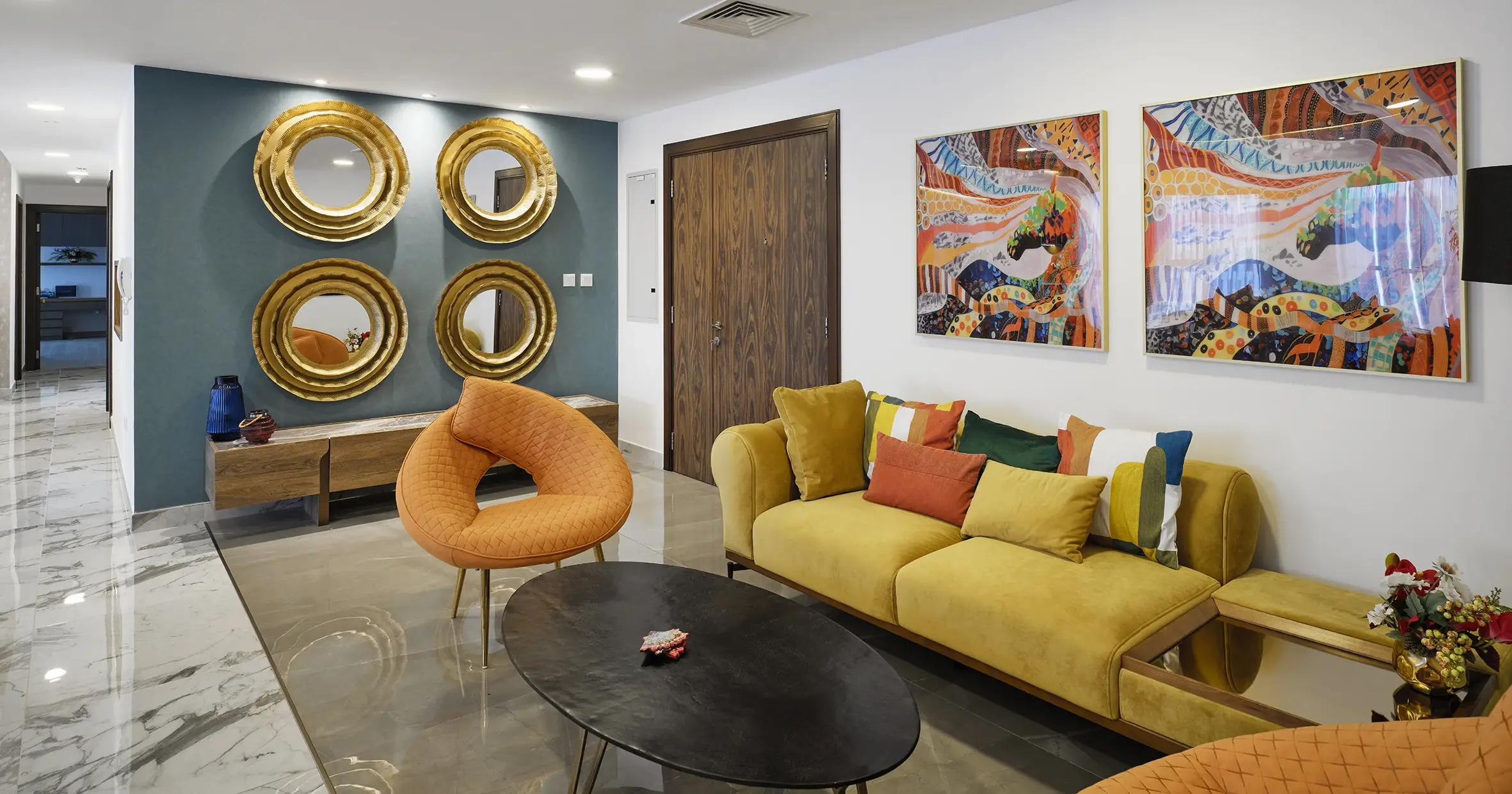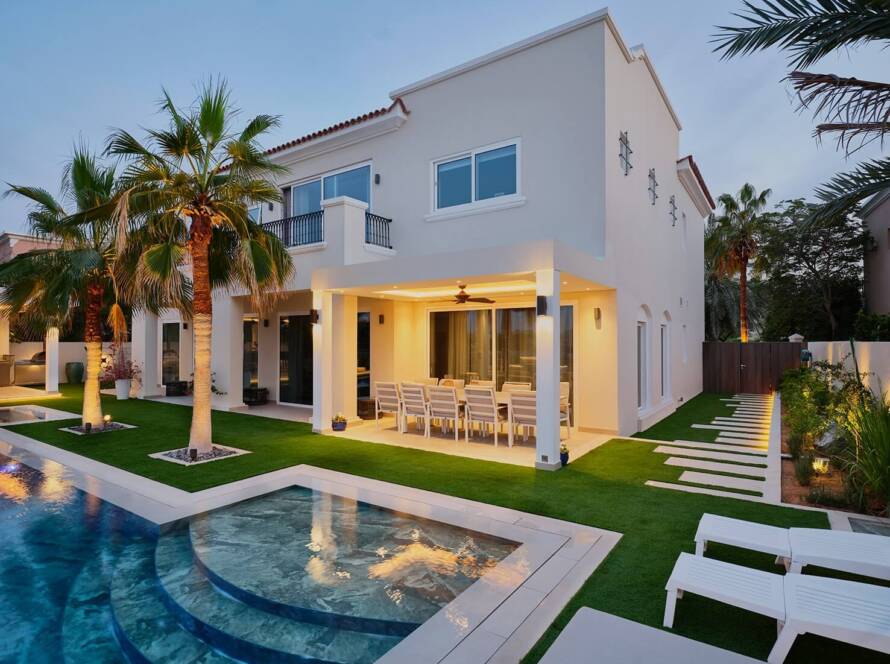The living room is undoubtedly the focal point of many homes. It is a space for fun, entertainment, laughter and enjoyment with family and friends. It is also a room where you can showcase your personal style. Interior design for living rooms needs to balance elegance, comfort and style. Achieving all this in one space can be tricky. You want to impress guests. At the same time, you want the living room interior design to be warm and inviting. How do you make a strong first impression without compromising on comfort? We’ve made balancing all of these requirements easy for you! Read on for some stylish tips and tricks to add oomph to your living room space.
Where To Begin?
It’s easy to jump straight to choosing finishes, throws and pillows for your living room. After all, this is the most fun part of living room interior design. But before you even get to this stage, it is important to have a vision – an idea for what you want your living room to look like. Everything should feed into this main idea.
What Is The Main Purpose Of The Living Room?
To answer this question, you first need to decide the various activities you will use the living room for. What does ‘living’ mean to you? Does it mean having a workspace – will you be spending a lot of time on your laptop? Do you plan on having a television in the living room or do you have a separate family room for TV watching? Are you a sports fan – will you be watching sporting events with friends and family at home? Would you like to have a reading cor
Mix Styles For A Fresh Look
People are often afraid to mix styles. They feel this might make the design seem incohesive. Quite the opposite is true. Adding a vintage piece of furniture, artwork or even lighting fixtures into a modern setting can create the excitement that gives the interiors its charm. It adds an element of surprise.
Rather than looking out of place, a combination of styles will add visual interest to your living room, provided that the elements enhance the overall vision for the room.
ner in your living room? These are some of the things you need to think about as the first step for interior design for living rooms.
Things To Avoid In Interior Design For Living Rooms
Love your space. Design it so that you enjoy spending time in it. Let the design reflect your tastes and preferences. Don’t worry too much about making your living room impress other people. Focus on designing it so that you feel a sense of pride in your space.
-
Layout Plan For Interior Design For Living Rooms
Once you know what you want to do in your living room, this is the next step. Very often, we have clients who buy furniture they have liked or have owned for a long time and then ask us to ‘fit’ it into the living room.
The layout plan is the foundation for good living room interior design. Rather than trying to fit furniture into your living room, first, plan the space based on the various uses. Interior design living room floor plans are the key to successful living room design.
Drawing up a furniture layout plan is much more than just the placement of your lounge. Most people stick their sofas against a wall, put a TV on the opposite wall and think they are done.
Think carefully about creating areas for conversation – you can design more than one seating arrangement if you have space.
Also, consider flow. People should be able to move easily around the living room without knocking into furniture.
You might also want to consider creating a focal point in your living room that wows visitors as soon as they enter. This will ground the entire living room, especially if its a large, multi-functional space.
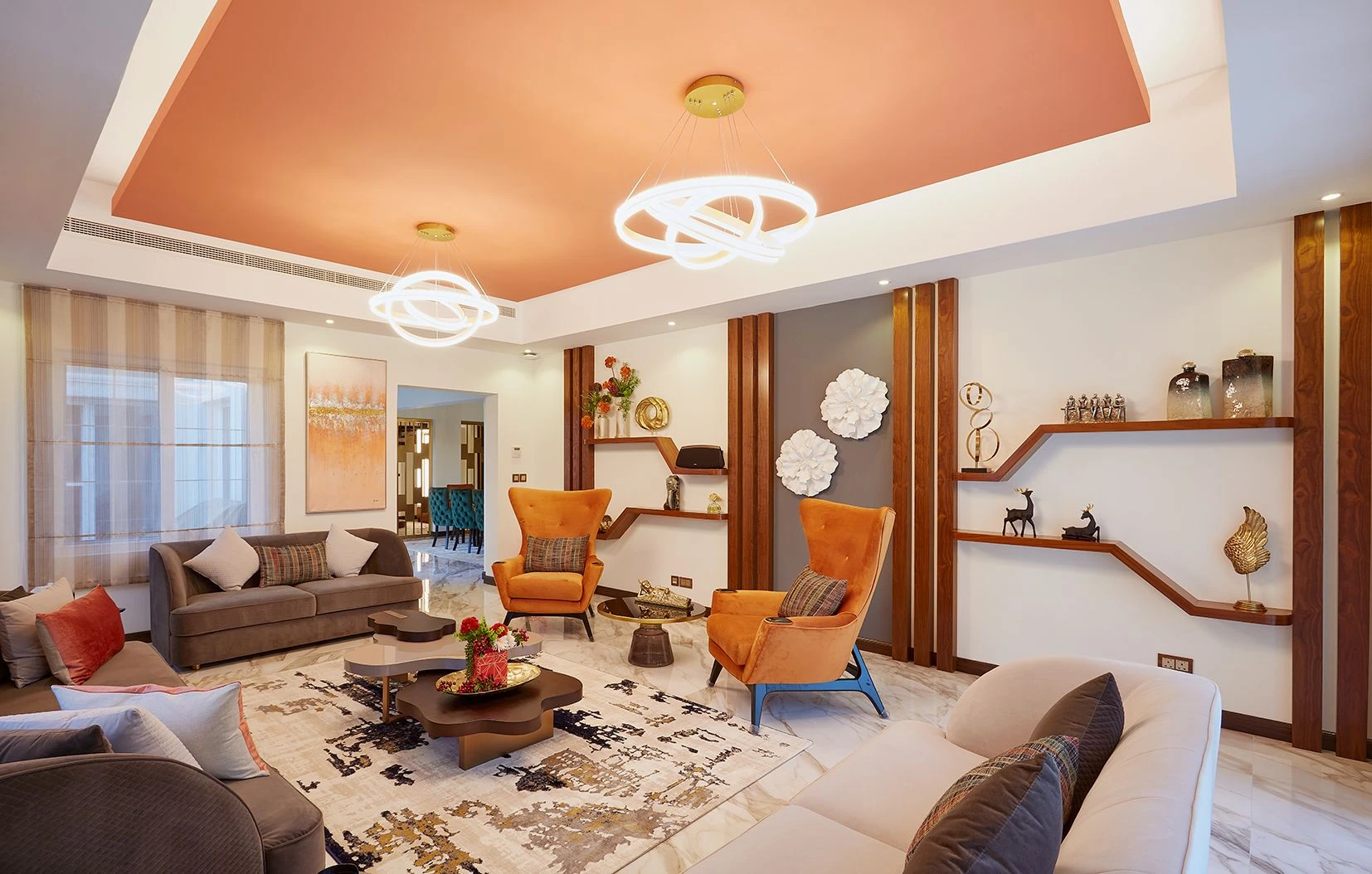
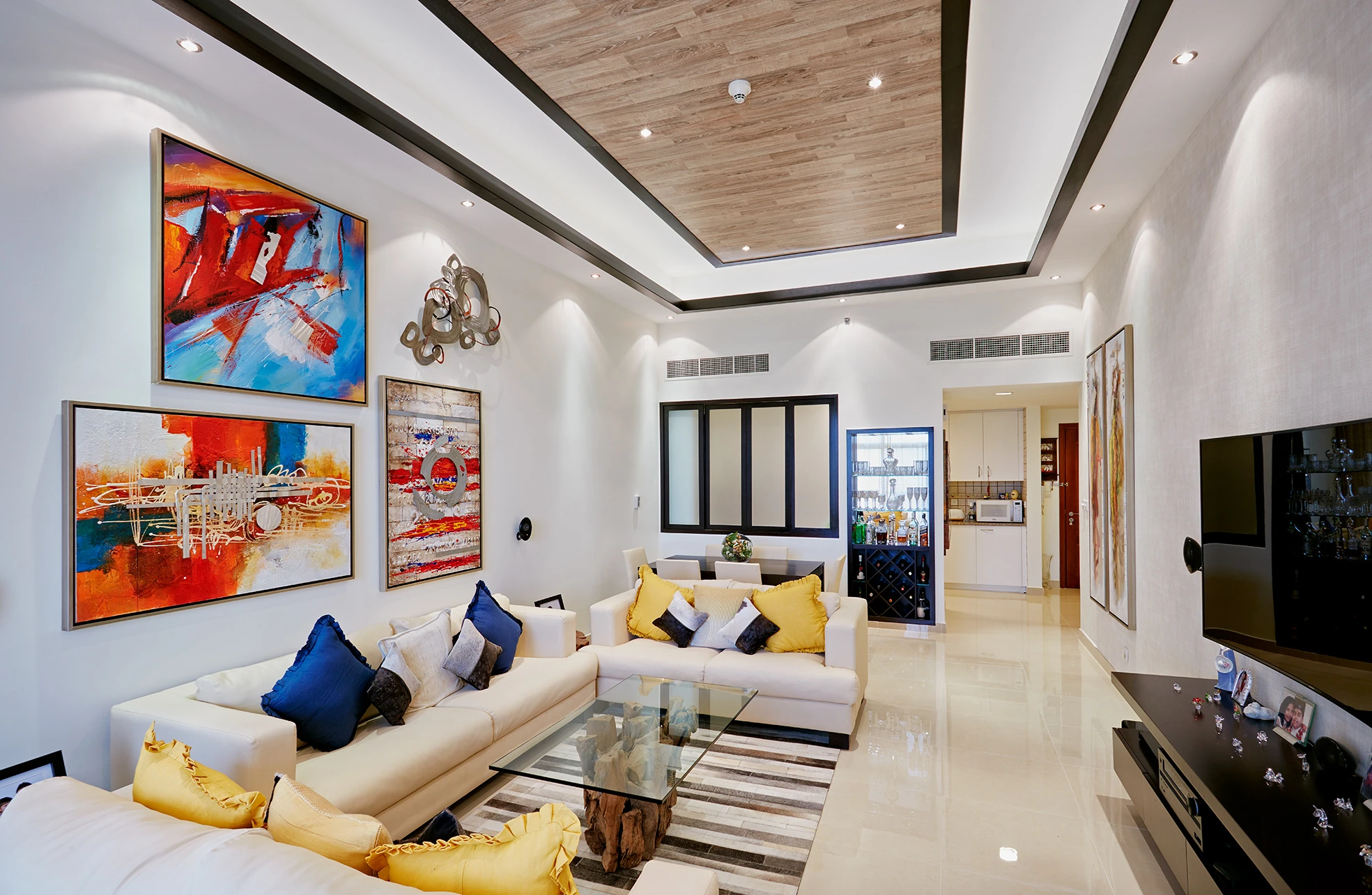
-
Elements Of Interior Design For Living Rooms
This is where your personal style shines through. No two living rooms are the same. You can try to copy a living room that you have seen and liked in a magazine or on a website, but it will not work for you if it is not customized for your needs.
Bring your space to life with these elements that are important for interior design for living rooms.
-
Color Schemes For Interior Design For Living Rooms
Decide your color palette according to the style you are going for. Modern designs are more partial to monochromatic, neutral color palettes.
With a neutral palette, accessories such as paintings, cushions, plants, and curtains come alive within the space. Light colors are soothing and make the living room look larger. Darker colors are energizing, but tend to make space feel smaller.
For those who love color, opt for vibrant fabrics for sofas and chairs. Green, turquoise, rust orange, and mustard yellows are popular accent colors. You can go even bolder with stark black and white fabric. But make sure to keep your walls neutral.
If your walls have vibrant colors, then opt for neutral shades for your lounges and chairs. You can always use pillow covers in the same accent color as the walls to tie the design together.
Don’t overlook flooring. A rich wooden flooring can add depth and character to interior design for living rooms. Alternately, carpets and rugs can provide color is that’s what you’re looking for.
-
Light It Up
Lighting can be used to create different moods for different activities. Soft lighting is great when you want to curl up with a book and chill out on the sofa.
Bright lighting is more suited to dinner parties or get-togethers, where the mood is more upbeat.
Use the light from different sources to add depth to the room. Layered lighting creates an even distribution of light, eliminating bright spots or dark corners.
Concealed LED strip lights can be combined with warm-colored spotlights to create an ambiance for a party. LED strip lighting can also be used to enhance a feature in the living room.
Remember that table and floor lamps can add flexibility to the lighting. They are particularly useful when you have zones in the living room that might need different levels of light.
Opt for fixtures that enhance the style of your living room. If you are looking to combine styles, lighting is a great way to introduce a vintage element into a modern setting or vice-versa.
Don’t forget the ceiling. Light high ceilings to draw the eye upwards and give the illusion of space. You could also vary the ceiling height to differentiate between different zones in your living room.
If you have a grand central seating arrangement, you could keep the ceiling above it high and drop the ceiling in the fringe areas. Remember, a striking chandelier can make a powerful statement, so use it as another light source if it goes with your theme.
Walls are like a blank canvas. You can ‘paint’ them with your unique style to personalize the look of your living room.
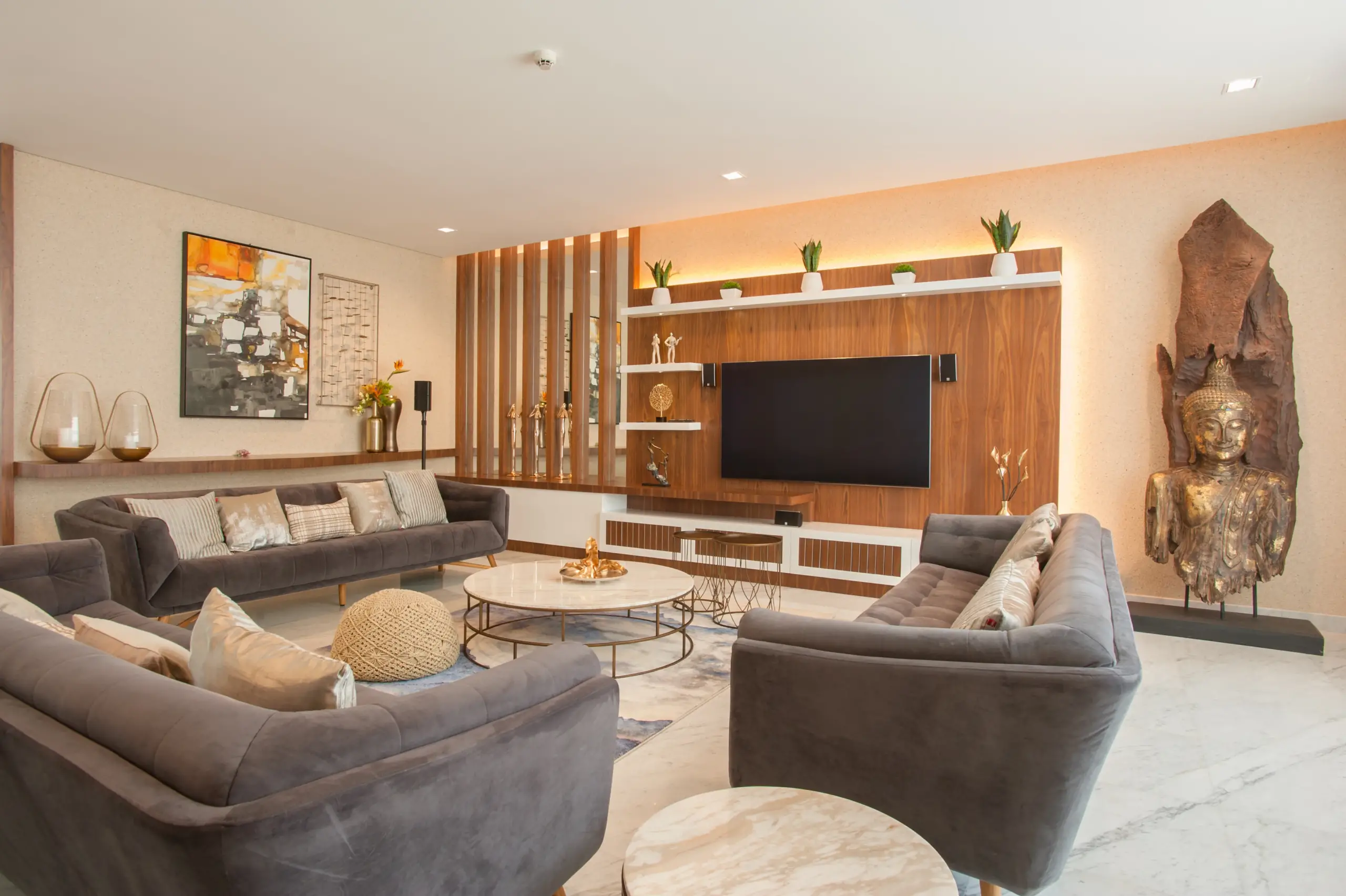
Here are some of the many ways you can enhance the look of your living room walls.
Wall art is one of the most popular forms of expression. This can take several forms: textured walls that are paneled with leather, wood or metal finishes add a bold flavor to any living room. Multi-media murals, paintings, and photo walls are also popular in living room interiors.
Cladding walls with marble, stone or slate immediately makes them a focal point. This also introduces an element of luxury in interior design for living rooms. You can find some stunning wall cladding options here.
If you really want to make your living room stand out, textured wallpapers might be the perfect solution. These add dimensional depth to the living space, giving it a bold character. Omexco has a wide variety of eye-catching textured wallpapers that create a stunning effect.
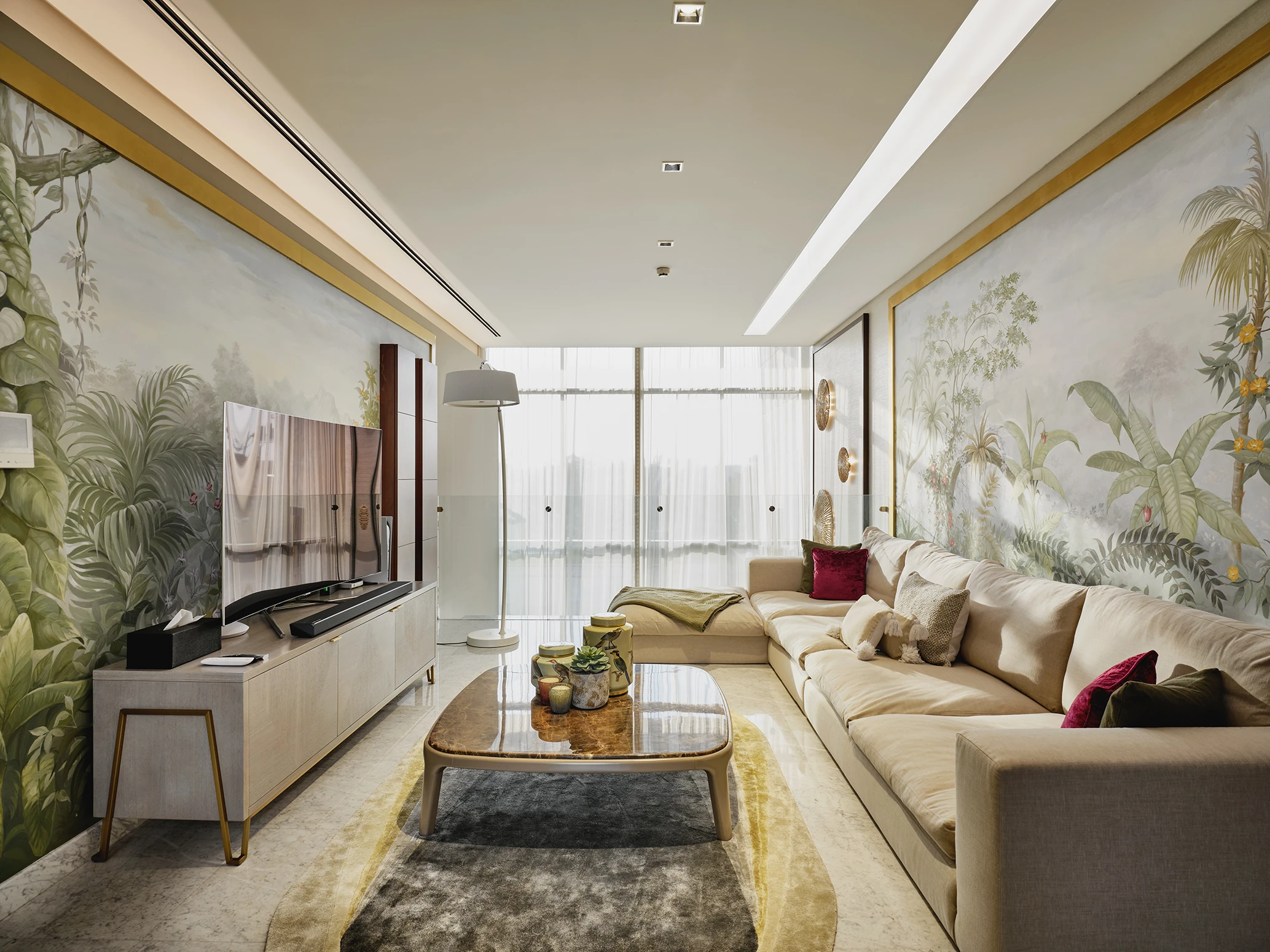

There are many ways to accessorize your living room interior.
-
Plants
Plants can energize your living room interior by adding a breath of freshness. Tall plants make a big impact on the interiors. Large banana plants, Areca or Kentia palms, Song of India plants and Dracaena varieties all thrive in interior spaces. Living walls are another way of bringing life to a living room. They make striking focal points and also provide a seamless connection between indoor and outdoor spaces.
-
Flooring, Carpets, And Rugs
The material you choose for flooring will depend on the theme of your living room. Large-format tiles are great for a modern vibe as there are fewer grout joints. Porcelain tiles, which are popular for interior flooring, come in many large format sizes – 1 x 1m, 1.2x 1.2 m , 60×120 cms , or 1.2 m x 2.4m. These tiles define the way you will place things on them. You can also choose marble, wood or parquet flooring, depending on the style of your living room interiors.
Carpets and rugs tie the space together. The key to choosing a carpet is the size. A carpet that is too small will make the room look disjointed. The carpet should be large enough so that most of the seating arrangement sits on it.
Rugs can also be used to define areas, such as a reading corner or the entrance to the living room.
Again, make sure your flooring treatment works well with the walls and ceilings. All these elements working together can enhance the interior design for living rooms.
-
Other Accessories
There are many other accessories that combine to personalize your living room interiors. Sculptures, candles, pottery, and figurines can all contribute to the vibe you are looking for. It may take time to curate these from different sources, but they will make the design feel well thought out and purposeful.
Don’t underestimate window treatments. Although the days of heavy drapery are mostly gone, sheer curtains can give the living room a bright and airy feeling. You can have blackout curtains to use when watching TV. The layering and textures of the drapes will also give the room a finished look.

-
Artwork
The artwork is an effective way to enhance your living space, but if you get its placement wrong, it can unbalance your entire living room interiors. Mistakes in placing artwork too high or low are glaringly obvious and would be difficult to miss. In general, artwork should be hung at eye level.
However, this is dependant on the room conditions. If your living room has a low ceiling, or if you are too tall, then this rule may not apply.
Similarly, the right size of the artwork is very important. A small art piece on a large wall will look out of place. Large artworks make a grand impact on walls, so choose wisely.
Whichever form of wall art you end up choosing, make sure it complements the themes and color palette of your living room interior.
Accessories are much more than a collection of trinkets and artifacts. They tell your story. They are an opportunity to add your personal touch to the living room – to lay claim to space as your own.
It’s A Living Room Not A Museum
Interior design for living rooms should look chic and sophisticated without feeling cold or unwelcoming. Avoid cramming the room with a ton of artifacts. Clutter can undermine any style. Choose a few pieces that tell your story and display them creatively.
Many clients make the mistake of going to a store and buying all the furniture from the same place. They think that similar pieces of furniture will make the room look more organized. On the contrary, this gives the living room a showroom feel – like going to IKEA and seeing one of their rooms on display.
You need to add in a centerpiece or a focal point. Also, leave enough in your budget for accessories. It’s the little details that make the difference. Invest in the more prominent furniture such as an armchair, a lounge or dining table. These are statement pieces that can anchor a room and are worth spending on. The lighting, artwork, and textiles in the room will also give it a designed look, adding in your personal preferences.
Milestone – Experts In Interior Design For Living Rooms
At Milestone, we have designed living rooms of many different styles and sizes. But they have all had one thing in common – they reflect the likes and tastes of our clients. This is what sets your living room apart from others.
We pride ourselves on understanding how each of our clients is unique and incorporating this individuality into our designs. No two living rooms we have designed are the same.
Tell us what you want, what you like and what you don’t and we will build your design around your vision.


